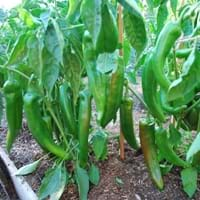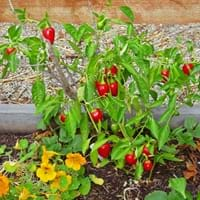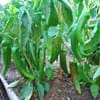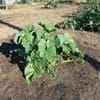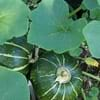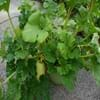Life Span
Perennial
Annual
Origin
Mexico, Central America, South America
Mexico, Central America, South America
Types
Capsicum baccatum
Capsicum chinense
Capsicum eximium
Capsicum frutescens
Capsicum pubescens
Not Available
Number of Varieties
Not Available
Habitat
Hillside, Lower slopes, shaded fields, Well Drained
Open areas
USDA Hardiness Zone
10-11
Not Available
Sunset Zone
A1, A2, A3, H1, H2, 1a, 1b, 2a, 2b, 3a, 3b, 4, 5, 6, 7, 8, 9, 10, 11, 12, 13, 14, 15, 16, 17, 18, 19, 20, 21, 22, 23, 24
A1, A2, A3, H1, H2, 1a, 1b, 2a, 2b, 3a, 3b, 4, 5, 6, 7, 8, 9, 10, 11, 12, 13, 14, 15, 16, 17, 18, 19, 20, 21, 22, 23, 24
Habit
Upright/Erect
Upright/Erect
Flower Color
White, Ivory
White
Flower Color Modifier
Bicolor
Bicolor
Fruit Color
Red, Green
Red, Green
Leaf Color in Spring
Dark Green, Green
Dark Green
Leaf Color in Summer
Green, Dark Green
Green
Leaf Color in Fall
Green, Dark Green, Black
Green, Black
Leaf Color in Winter
Green, Dark Green
Dark Green
Leaf Shape
Acuminate
Ovate
Plant Season
Spring, Summer, Fall
Spring, Summer, Fall
Sunlight
Full Sun
Full Sun
Growth Rate
Medium
Medium
Type of Soil
Loam
Loam, Sand
The pH of Soil
Neutral
Neutral
Soil Drainage
Well drained
Well drained
Bloom Time
Spring, Summer, Indeterminate
Spring, Summer, Indeterminate
Tolerances
Drought
Drought
Where to Plant?
Ground
Container, Ground
How to Plant?
Seedlings
Seedlings, Transplanting
Plant Maintenance
Medium
Medium
Watering Requirements
Water frequently while growing
Do Not over Water
In Summer
Lots of watering
Lots of watering
In Spring
Moderate
Moderate
In Winter
Average Water
Average Water
Soil Type
Loam
Loam, Sand
Soil Drainage Capacity
Well drained
Well drained
Sun Exposure
Full Sun
Full Sun
Pruning
Remove damaged leaves, Remove dead branches, Remove dead leaves
Remove damaged leaves, Remove dead branches, Remove dead leaves
Fertilizers
All-Purpose Liquid Fertilizer, Apply N-P-K
All-Purpose Liquid Fertilizer
Pests and Diseases
Aphids, Bacterial leaf spot, Beet armyworm, Damping-off, Flea Beetles, Fusarium wilt, Red blotch
Not Available
Plant Tolerance
Drought
Drought
Flowers
Insignificant
Yes
Flower Petal Number
Single
Single
Foliage Texture
Medium
Medium
Foliage Sheen
Glossy
Glossy
Attracts
Aphids, Beet armyworms, Flea beetles
Not Available
Allergy
contact allergic dermatitis, Rhinitis
Hives, Rash
Aesthetic Uses
Bog Garden, Borders
Showy Purposes
Beauty Benefits
Not Available
Not Available
Environmental Uses
Air purification
Air purification
Medicinal Uses
Antirheumatic, Appetizer, Intestinal irritations
cholesterol-lowering, Low calories, Vitamin C
Part of Plant Used
Flowers, Fruits
Fruits
Other Uses
Not Available
Used As Food
Used As Indoor Plant
No
No
Used As Outdoor Plant
Yes
Yes
Garden Design
Container, Edible, Herb / Vegetable, Mixed Border, Tropical
Bedding Plant, Container, Edible, Herb / Vegetable, Mixed Border, Tropical
Botanical Name
CAPSICUM annuum 'Big Chile'( Longum Group)
CAPSICUM annuum 'Cherry Bomb'
Common Name
Big Chile Pepper, Chile Pepper
Cherry Bomb Pepper, Cherry Pepper
In Hindi
Chile Pepper
Cherry Bomb Pepper
In German
Chile-Pfeffer
Cherry Bomb Pfeffer
In French
Chili Pepper
Cherry Bomb Pepper
In Spanish
La pimienta de Chile
Bomba de cereza Pimienta
In Greek
Χιλή πιπέρι
Cherry Bomb Πιπέρι
In Portuguese
pimenta do Chile
Cherry Bomb Pimenta
In Polish
Chile Pepper
Cherry Bomb Pepper
In Latin
Chile Pepper
Cherry Bomb Pepper
Phylum
Tracheophyta
Anthophyta
Class
Magnoliopsida
Eudicotyledones
Order
Solanales
Solanales
Family
Solanaceae
Solanaceae
Clade
Asterids, Eudicots
Angiosperms
Tribe
Not Available
Not Available
Subfamily
Not Available
Not Available
Number of Species
Not Available
Not Available
Season and Care of Chile Pepper and Cherry Bomb Pepper
Season and care of Chile Pepper and Cherry Bomb Pepper is important to know. While considering everything about Chile Pepper and Cherry Bomb Pepper Care, growing season is an essential factor. Chile Pepper season is Spring, Summer and Fall and Cherry Bomb Pepper season is Spring, Summer and Fall. The type of soil for Chile Pepper is Loam and for Cherry Bomb Pepper is Loam, Sand while the PH of soil for Chile Pepper is Neutral and for Cherry Bomb Pepper is Neutral.
Chile Pepper and Cherry Bomb Pepper Physical Information
Chile Pepper and Cherry Bomb Pepper physical information is very important for comparison. Chile Pepper height is 61.00 cm and width 45.70 cm whereas Cherry Bomb Pepper height is 61.00 cm and width 61.00 cm. The color specification of Chile Pepper and Cherry Bomb Pepper are as follows:
Chile Pepper flower color: White and Ivory
Chile Pepper leaf color: Dark Green and Green
Cherry Bomb Pepper flower color: White
- Cherry Bomb Pepper leaf color: Dark Green
Care of Chile Pepper and Cherry Bomb Pepper
Care of Chile Pepper and Cherry Bomb Pepper include pruning, fertilizers, watering etc. Chile Pepper pruning is done Remove damaged leaves, Remove dead branches and Remove dead leaves and Cherry Bomb Pepper pruning is done Remove damaged leaves, Remove dead branches and Remove dead leaves. In summer Chile Pepper needs Lots of watering and in winter, it needs Average Water. Whereas, in summer Cherry Bomb Pepper needs Lots of watering and in winter, it needs Average Water.
